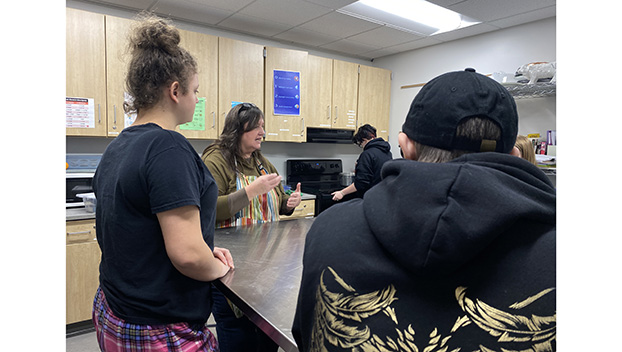Order up: Jessamine Co. teacher helps students hone their culinary skills
Published 10:30 am Friday, June 23, 2023

- Liz Spurlock has taught her students to cook everything from traditional Southern comfort meals to staples of West African cuisine. (Photo by Gillian Stawiszynski)
|
Getting your Trinity Audio player ready...
|
At the Providence School, passers-by will find a mini-kitchen in a hallway that leads into the cafeteria. It’s bigger than a small apartment’s, but smaller than the average IKEA model kitchen.
But, the entirety of this alternative public school’s population is not served daily meals from this kitchen. Instead, it’s used for a foods class taught by Liz Spurlock, who also teaches art class and organizes the annual Empty Bowl Lunch.
Since Spurlock was five years old, her role in her one-parent home was to cook the meals. Her mother worked, her older sister ran errands, and her younger brother did other chores. But she didn’t see cooking as a chore. She enjoyed the “chemistry behind it” and learned from Betty Crocker’s books and her granny.
Spurlock originally started the foods class at the school’s previous Wilmore campus. She gave up one of the rooms her classes used to craft ceramics, and applied for a grant to fund the course.
Spurlock brought the idea to her supervisors and she said, “ ‘It won’t cost you anything. It’ll just be another elective.”
The grant came through, and she was able to start teaching. She began by creating a list of 30 foods she thought everyone should know how to make.
From potato soup and chicken and dumplings to West African chicken peanut soup and all sorts of ways to prepare eggs- Spurlock walks her 10-student class through the whole process and then supervises them as they prepare the meal of the day. She also has the help of paraprofessional educator, Laura Thompson, to keep the students engaged.
Before starting any food prep, Spurlock walks her students through the recipe and process in class and then asks them about their own experiences of the dish at home. “How does your family prepare potato soup?” She asks, and students can connect through household differences.
Spurlock is taking advantage of this and creating a cookbook with her family’s recipes and recipes from her students’ families. The high schoolers already have access to a google drive with more than 30 recipes, but they’ll have access to this book one day, too.
“I want them to learn how to feed themselves and I think my food, arrogantly, is better than most restaurants and I know mine is healthier and cleaner,” Spurlock said.
Although she focuses on the basic rules of cooking and food, Spurlock relies heavily on ingenuity in her teaching.
She teaches her students how to make cake flour at home by replacing one tablespoon of flour with cornstarch instead of relying on boxed cake flour, how to make almond milk, and how to work with what they have in their home.
But- nutrition, taste and balance are the most important themes of this class. If the students want biscuits, they’ll be from scratch, unlike Pillsbury. If the class is making soup, it won’t be canned. When the class cooks macaroni and cheese, it will not be dry. If the students want an easy meal at home- Spurlock teaches them to prioritize whole foods.
“I want them to be able at home to do more than a ramen noodle and if you’re gonna do ramen how about we sauté some veggies in there, how about you get rid of that flavor pack that’s all salt and msg and use your own spices. I teach them how to make their own taco mix and their own seasonings because, one, they’re cheaper and two, they don’t have flour and sugar in them,” Spurlock said.
Most of her students’ diets, Spurlock said, are meat and dairy-heavy. So she aims to teach them the nutritional balance of meals while teaching her class that balanced meals can still taste good.
“There’s all sorts of ways you can hide veggies into your food and still get the nutrition. So I told them how they can, you know, roast them in polenta, get them into pasta sauces and bolognese and get the celery and carrots and onions. You can get all that in if you do a fine chop,” Spurlock said.
Former student Rydder Strange didn’t cook before this class. He said his mom and sister just cooked for him while he did other chores. But, thanks to this class, Strange said he is learning a lot.
“It’s a good class overall because kids should definitely be able to learn how to cook before they’re on their own after they graduate and move out,” Strange said.
And Spurlock does ensure her students are picking up cooking knowledge through assessments. She said they’re teaching them to be “little food snobs” and critique everything they make.
“We gotta go through all the different things, and they’ve gotta evaluate it. Does it look like it’s supposed to? Does it smell like it’s supposed to? Does it have the correct texture? Is it burnt, is it raw?” Spurlock said.
For end-of-semester exams, Spurlock sets up a skills station of seven tasks the students must perform. Though Spurlock won’t help the students through the tasks- classmates can give each other tips while they work through the exam. Classmates then critique the completed tasks.
These tasks involve bringing water to a rolling boil, being able to spot room-temperature butter, and being able to crack an egg.
Spurlock said this exam is more practical because “They physically have to do things.” Although there are a few paper assignments and tests, Spurlock wants to ensure students are physically ready to cook for themselves.





